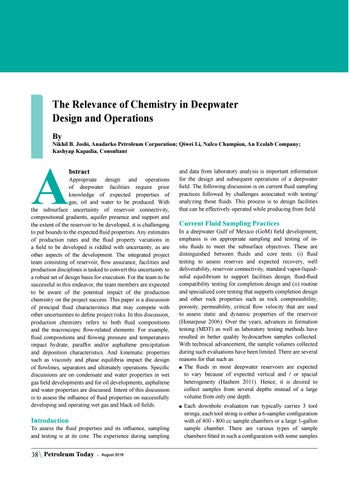The Relevance of Chemistry in Deepwater Design and Operations By
Nikhil B. Joshi, Anadarko Petroleum Corporation; Qiwei Li, Nalco Champion, An Ecolab Company; Kashyap Kapadia, Consultant
A
bstract
Appropriate design and operations of deepwater facilities require prior knowledge of expected properties of gas, oil and water to be produced. With the subsurface uncertainty of reservoir connectivity, compositional gradients, aquifer presence and support and the extent of the reservoir to be developed, it is challenging to put bounds to the expected fluid properties. Any estimates of production rates and the fluid property variations in a field to be developed is riddled with uncertainty, as are other aspects of the development. The integrated project team consisting of reservoir, flow assurance, facilities and production disciplines is tasked to convert this uncertainty to a robust set of design basis for execution. For the team to be successful in this endeavor, the team members are expected to be aware of the potential impact of the production chemistry on the project success. This paper is a discussion of principal fluid characteristics that may compete with other uncertainties to define project risks. In this discussion, production chemistry refers to both fluid compositions and the macroscopic flow-related elements. For example, fluid compositions and flowing pressure and temperatures impact hydrate, paraffin and/or asphaltene precipitation and deposition characteristics. And kinematic properties such as viscosity and phase equilibria impact the design of flowlines, separators and ultimately operations. Specific discussions are on condensate and water properties in wet gas field developments and for oil developments, asphaltene and water properties are discussed. Intent of this discussion is to assess the influence of fluid properties on successfully developing and operating wet gas and black oil fields.
Introduction
To assess the fluid properties and its influence, sampling and testing is at its core. The experience during sampling
38 Petroleum Today
- August 2018
and data from laboratory analysis is important information for the design and subsequent operations of a deepwater field. The following discussion is on current fluid sampling practices followed by challenges associated with testing/ analyzing those fluids. This process is to design facilities that can be effectively operated while producing from field.
Current Fluid Sampling Practices
In a deepwater Gulf of Mexico (GoM) field development, emphasis is on appropriate sampling and testing of insitu fluids to meet the subsurface objectives. These are distinguished between fluids and core tests: (i) fluid testing to assess reserves and expected recovery, well deliverability, reservoir connectivity, standard vapor-liquidsolid equilibrium to support facilities design, fluid-fluid compatibility testing for completion design and (ii) routine and specialized core testing that supports completion design and other rock properties such as rock compressibility, porosity, permeability, critical flow velocity that are used to assess static and dynamic properties of the reservoir (Honarpour 2006). Over the years, advances in formation testing (MDT) as well as laboratory testing methods have resulted in better quality hydrocarbon samples collected. With technical advancement, the sample volumes collected during such evaluations have been limited. There are several reasons for that such as: Ă“ The fluids in most deepwater reservoirs are expected to vary because of expected vertical and / or spacial heterogeneity (Hashem 2011). Hence, it is desired to collect samples from several depths instead of a large volume from only one depth. Ă“ Each downhole evaluation run typically carries 3 tool strings, each tool string is either a 6-sampler configuration with of 400 - 800 cc sample chambers or a large 1-gallon sample chamber. There are various types of sample chambers fitted in such a configuration with some samples



